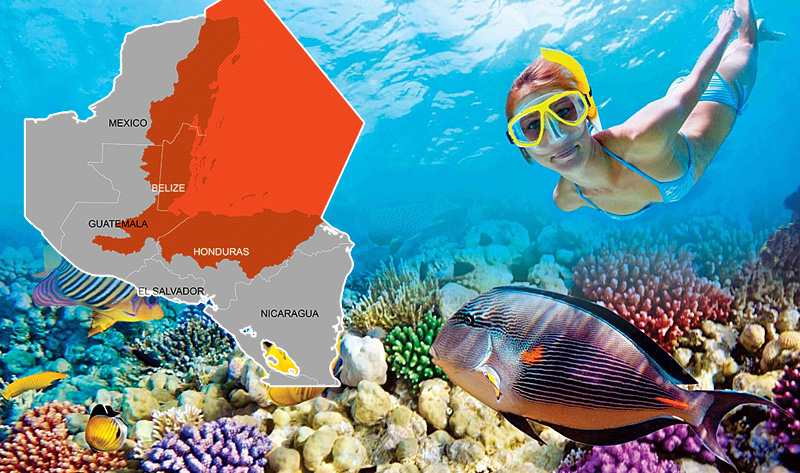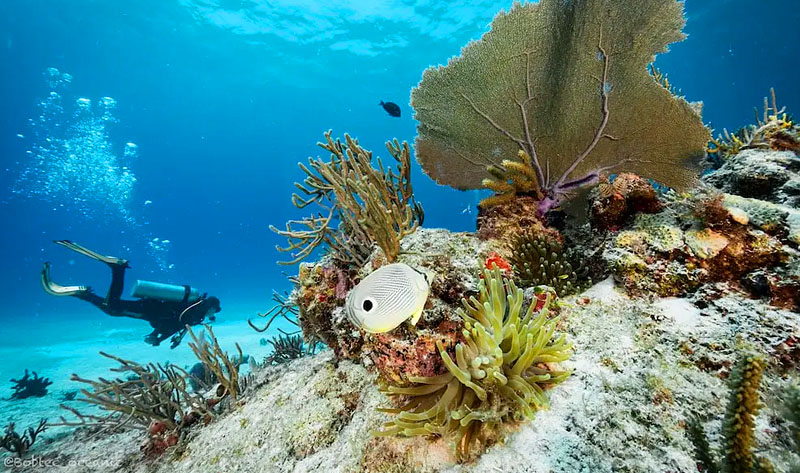The Ultimate Guide to Snorkeling and Diving in the Great Maya Reef
Date: 13/07/2023
Cancun and the Riviera Maya are famous around the world for their stunning coastal beauty and vibrant marine ecosystems, none more impressive than the Northern end of the Great Maya Reef. Stretching over 700 miles along the Yucatan Peninsula and Central America, from Contoy Island all they way south to Honduras, this magnificent coral reef system is the second largest in the world. There are many ways to experience the underwater wonders of the Great Maya Reef but none match snorkeling and SCUBA diving the reef yourself to see its stunning glory with your own eyes. In this guide we'll take you through everything you need to know for an unforgettable snorkeling or diving experience in the Great Maya Reef.
The Great Maya Reef
Formally known as the Mesoamerican Barrier Reef System, is a UNESCO World Heritage site and a treasure trove of biodiversity. It is home to over 65 species of coral, 500 species of fish, and a myriad of species of other creatures like colorful nudibranchs and inquisitive octopuses, friendly sea turtles and even the odd dolphin. Understanding the significance of this ecosystem sets the stage for the awe-inspiring snorkeling or diving experience that awaits you under the sea’s mirror surface.
Snorkeling
An easier more accesible experience than SCUBA, exploring the Shallow Depths: Snorkeling is an excellent option for those who want to discover the beauty of the Great Maya Reef without the need for specialized training or equipment. With crystal-clear turquoise waters and an often calm sea, you can easily observe the vibrant coral formations and swim alongside tropical fish that inhabit the shallower portions of the reef, where the reef itself can be less than 10 ft. under the surface. While not every part of the reef is open to snorkeling, there are spots all throughout the coast. Popular snorkeling spots include Akumal, Puerto Morelos, and Isla Mujeres.
Diving
For a deeper (pun fully intended) and more immersive experience, SCUBA diving allows you to delve deeper into the Great Maya Reef's underwater world, coming as close as a few inches from the colorful dwellers of the reef. Certified divers can explore a myriad of dive sites with varying depths and levels of difficulty, but there are more than enough beautiful sites that are accessible to even the newest divers so don’t let this deter you from partaking in the experience. Standing out amongst the dive sites is MUSA, the museum of submerged art, where the Great Maya Reef meets human art in the form of a submerged sculpture garden.

Best Season to Snorkel and Dive
The best time to snorkel or dive the Great Maya Reef is simply: whenever you’re here. These activities are open year round, and every season has its ups and downs. The summer brings a greater chance of rain and generally a lower visibility but more sunny, beautiful weather days, while the months of November to April offer better visibility underwater and generally calmer seas but also more common storms that stop all water activities. The marine life you can encounter also depends on the season, but there isn’t a single season during which the reef isn’t teeming with life. The most important thing is to check local weather and water forecasts for the area you want to dive, as factors like seasonal storms or sargasso blooms can temporarily affect water clarity.
Practice Responsible Tourism
As visitors, it's crucial to be respectful of the natural environment to help protect the fragile ecosystem of the Great Maya Reef. Avoid touching or stepping on coral, as it can cause irreparable damage to the coral, and hurt yourself in the process. Choose eco-friendly tour operators that prioritize sustainability and adhere to the responsible snorkeling and diving practices which they will instruct you on. Additionally, consider participating in reef cleanup initiatives or educational programs that promote conservation efforts, they’re organized regularly so it is possible one is happening during your stay. And last but not least, remember to use reef-safe sunscreen, when you’re going diving but also any time you’re going into the water be it the sea or the cenotes.
Safety Tips and Precautions
SCUBA and snorkeling are both very safe activities, nevertheless there are some things that can be done to ensure they’re as safe as possible. Before embarking on any snorkeling or diving adventure, ensure your safety with these tips:
- Choose certified reputable tour operators with experienced, certified guides.
- Get a comprehensive briefing on safety procedures and the specific site conditions.
- Always dive or snorkel with a buddy and follow your guide.
- If you’re on SCUBA, don’t forget the rules: don’t hold your breath, monitor your air supply, dive within your limits, and adhere to decompression limits.
- Stay hydrated, protect yourself from the sun, and use appropriate gear for your activity.
- Do not try this activity while under the influence of drugs or alcohol, or if you’re wicked hungover: it won’t be fun and it won’t be safe.
Snorkeling and diving in the Great Maya Reef offer unparalleled opportunities to explore the underwater wonders of Cancun and the Riviera Maya. Whether you choose to snorkel the shallow reefs or embark on thrilling dives into the depths, the experiences are sure to leave you in awe of the region's natural beauty. By respecting the environment, practicing responsible tourism, and prioritizing safety, you can create unforgettable memories while contributing to the preservation of this magnificent coral reef system.
You may be interested:



